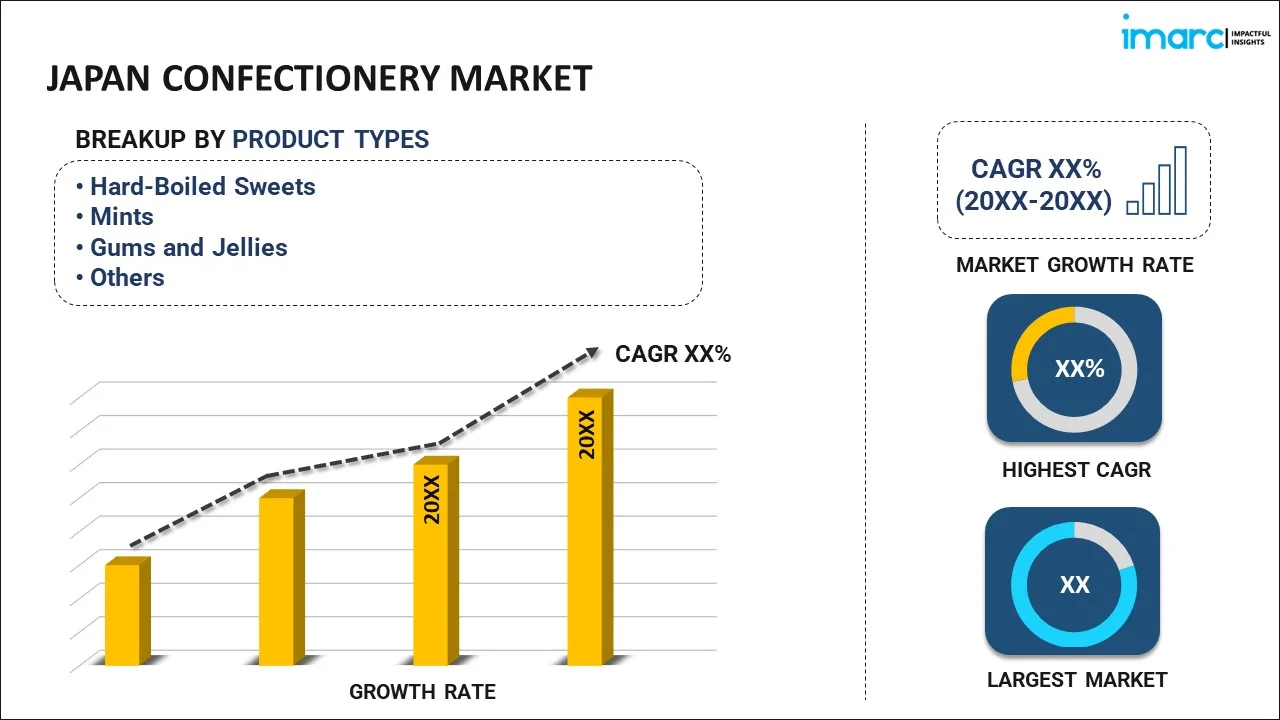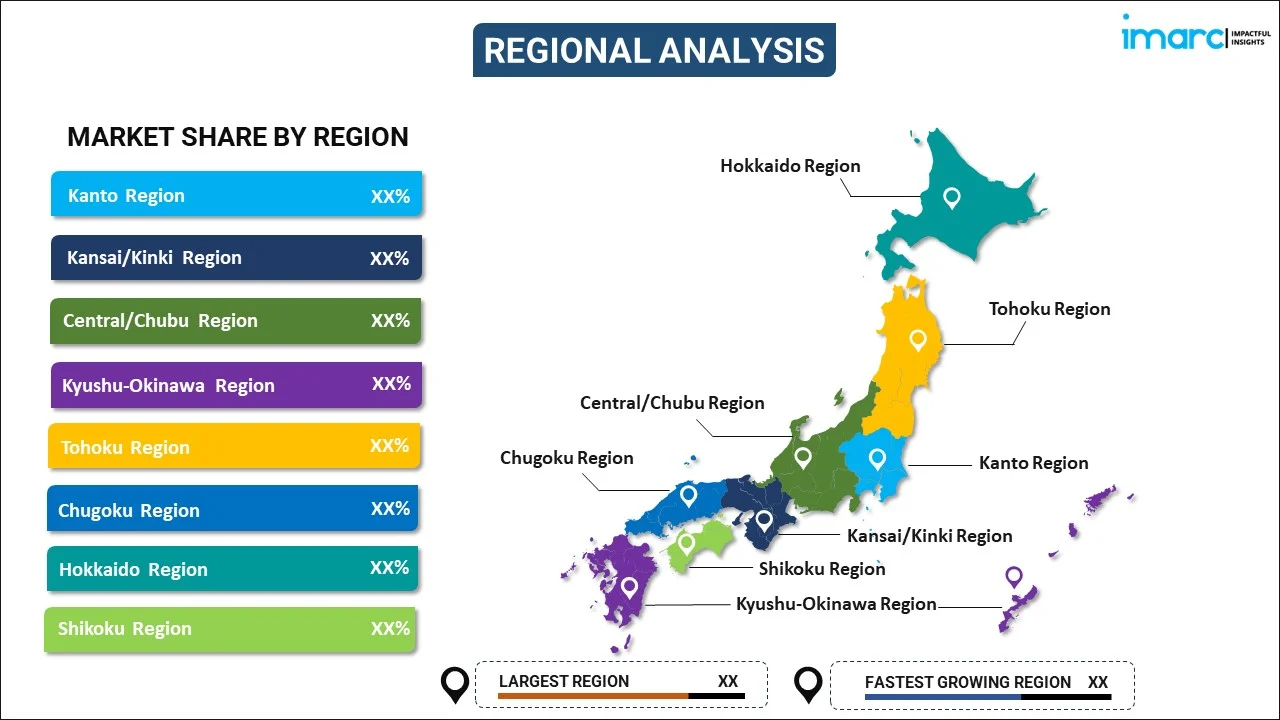
Japan Confectionery Market Report by Product Type (Hard-Boiled Sweets, Mints, Gums and Jellies, Chocolate, Caramels and Toffees, Medicated Confectionery, Fine Bakery Wares, and Others), Age Group (Children, Adult, Geriatric), Price Point (Economy, Mid-Range, Luxury), Distribution Channel (Supermarkets and Hypermarkets, Convenience Stores, Pharmaceutical and Drug Stores, Online Stores, and Others), and Region 2026-2034
Market Overview:
Japan confectionery market size reached USD 30.1 Billion in 2025. Looking forward, IMARC Group expects the market to reach USD 45.3 Billion by 2034, exhibiting a growth rate (CAGR) of 4.65% during 2026-2034. The increasing growth of e-commerce platforms that have allowed confectionery companies to reach a broader audience is primarily driving the market.
|
Report Attribute
|
Key Statistics
|
|---|---|
|
Base Year
|
2025 |
|
Forecast Years
|
2026-2034 |
|
Historical Years
|
2020-2025
|
| Market Size in 2025 | USD 30.1 Billion |
| Market Forecast in 2034 | USD 45.3 Billion |
| Market Growth Rate (2026-2034) | 4.65% |
Confectionery is a delightful and diverse category of food that encompasses a wide array of sweet treats. From colorful candies to decadent chocolates, confectionery has a special place in hearts and taste buds. These sugary creations have been enjoyed by people of all ages and cultures for centuries, bringing joy and satisfaction with every bite. One of the most beloved aspects of confectionery is its versatility. Confectionery isn't just about taste; it's a form of artistry, with skilled artisans crafting intricate designs and flavors that captivate the senses. It also plays a significant role in celebrations and traditions. It's a symbol of happiness, shared on birthdays, holidays, and special occasions. Beyond its sweetness, confectionery often brings people together, fostering connections and creating lasting memories. In conclusion, confectionery is a delightful world of sweetness, creativity, and tradition. It's a reminder that life's pleasures can be found in the simplest and sweetest of indulgences.
Japan Confectionery Market Trends:
The confectionery market in Japan, driven by a multitude of factors, has experienced consistent growth in recent years. Firstly, consumers' increasing disposable incomes have played a pivotal role in boosting demand for confectionery products. As people have more money to spend, they are more inclined to indulge in sweets and treats. Moreover, the changing lifestyles and hectic routines of modern society have led to a surge in demand for convenient, on-the-go snack options, which often include confectionery items. Furthermore, the evolving preferences of consumers towards healthier and natural ingredients have driven innovation within the confectionery market. Manufacturers have responded by introducing products with reduced sugar content, organic ingredients, and clean labels to meet the demand for healthier options. Additionally, the regional reach of confectionery brands, fueled by e-commerce, has expanded their market presence, leading to increased sales. In conclusion, the Japan confectionery market growth is expected to be driven by rising incomes, changing consumer lifestyles, health-conscious choices, and market expansion.
Japan Confectionery Market Segmentation:
IMARC Group provides an analysis of the key trends in each segment of the market, along with forecasts at the country level for 2026-2034. Our report has categorized the market based on product type, age group, price point, and distribution channel.
Product Type Insights:

- Hard-Boiled Sweets
- Mints
- Gums and Jellies
- Chocolate
- Caramels and Toffees
- Medicated Confectionery
- Fine Bakery Wares
- Others
The report has provided a detailed breakup and analysis of the market based on the product type. This includes hard-boiled sweets, mints, gums and jellies, chocolate, caramels and toffees, medicated confectionery, fine bakery wares, and others.
Age Group Insights:
- Children
- Adult
- Geriatric
A detailed breakup and analysis of the market based on the age group have also been provided in the report. This includes children, adult, and geriatric.
Price Point Insights:
- Economy
- Mid-Range
- Luxury
The report has provided a detailed breakup and analysis of the market based on the price point. This includes economy, mid-range, and luxury.
Distribution Channel Insights:
- Supermarkets and Hypermarkets
- Convenience Stores
- Pharmaceutical and Drug Stores
- Online Stores
- Others
A detailed breakup and analysis of the market based on the distribution channel have also been provided in the report. This includes supermarkets and hypermarkets, convenience stores, pharmaceutical and drug stores, online stores, and others.
Regional Insights:

- Kanto Region
- Kansai/Kinki Region
- Central/ Chubu Region
- Kyushu-Okinawa Region
- Tohoku Region
- Chugoku Region
- Hokkaido Region
- Shikoku Region
The report has also provided a comprehensive analysis of all the major regional markets, which include Kanto Region, Kansai/Kinki Region, Central/ Chubu Region, Kyushu-Okinawa Region, Tohoku Region, Chugoku Region, Hokkaido Region, and Shikoku Region.
Competitive Landscape:
The market research report has also provided a comprehensive analysis of the competitive landscape. Competitive analysis such as market structure, key player positioning, top winning strategies, competitive dashboard, and company evaluation quadrant has been covered in the report. Also, detailed profiles of all major companies have been provided. The companies in the market are adopting various strategic initiatives including new product launches and business alliances to gain a significant Japan confectionery market share.
Japan Confectionery Market Report Coverage:
| Report Features | Details |
|---|---|
| Base Year of the Analysis | 2025 |
| Historical Period | 2020-2025 |
| Forecast Period | 2026-2034 |
| Units | Billion USD |
| Scope of the Report | Exploration of Historical and Forecast Trends, Industry Catalysts and Challenges, Segment-Wise Historical and Predictive Market Assessment:
|
| Product Types Covered | Hard-Boiled Sweets, Mints, Gums and Jellies, Chocolate, Caramels and Toffees, Medicated Confectionery, Fine Bakery Wares, Others |
| Age Groups Covered | Children, Adult, Geriatric |
| Price Points Covered | Economy, Mid-Range, Luxury |
| Distribution Channels Covered | Supermarkets and Hypermarkets, Convenience Stores, Pharmaceutical and Drug Stores, Online Stores, Others |
| Regions Covered | Kanto Region, Kansai/Kinki Region, Central/ Chubu Region, Kyushu-Okinawa Region, Tohoku Region, Chugoku Region, Hokkaido Region, Shikoku Region |
| Customization Scope | 10% Free Customization |
| Post-Sale Analyst Support | 10-12 Weeks |
| Delivery Format | PDF and Excel through Email (We can also provide the editable version of the report in PPT/Word format on special request) |
Key Questions Answered in This Report:
- How has the Japan confectionery market performed so far and how will it perform in the coming years?
- What has been the impact of COVID-19 on the Japan confectionery market?
- What is the breakup of the Japan confectionery market on the basis of product type?
- What is the breakup of the Japan confectionery market on the basis of age group?
- What is the breakup of the Japan confectionery market on the basis of price point?
- What is the breakup of the Japan confectionery market on the basis of distribution channel?
- What are the various stages in the value chain of the Japan confectionery market?
- What are the key driving factors and challenges in the Japan confectionery?
- What is the structure of the Japan confectionery market and who are the key players?
- What is the degree of competition in the Japan confectionery market?
- How big is the confectionery market in Japan?
Key Benefits for Stakeholders:
- IMARC’s industry report offers a comprehensive quantitative analysis of various market segments, historical and current market trends, market forecasts, and dynamics of the Japan confectionery market from 2020-2034.
- The research report provides the latest information on the market drivers, challenges, and opportunities in the Japan confectionery market.
- Porter's five forces analysis assist stakeholders in assessing the impact of new entrants, competitive rivalry, supplier power, buyer power, and the threat of substitution. It helps stakeholders to analyze the level of competition within the Japan confectionery industry and its attractiveness.
- Competitive landscape allows stakeholders to understand their competitive environment and provides an insight into the current positions of key players in the market.
Need more help?
- Speak to our experienced analysts for insights on the current market scenarios.
- Include additional segments and countries to customize the report as per your requirement.
- Gain an unparalleled competitive advantage in your domain by understanding how to utilize the report and positively impacting your operations and revenue.
- For further assistance, please connect with our analysts.
 Request Customization
Request Customization
 Speak to an Analyst
Speak to an Analyst
 Request Brochure
Request Brochure
 Inquire Before Buying
Inquire Before Buying




.webp)




.webp)












